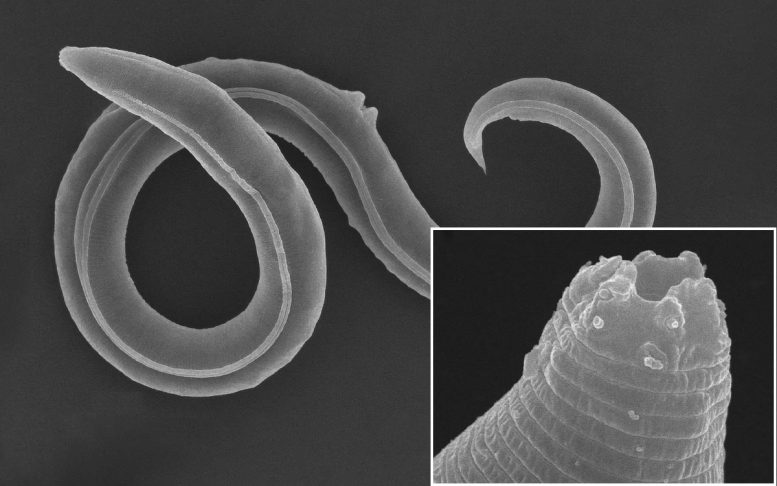
Scientists discovered ancient nematodes in the Siberian Permafrost, one of which was identified as a previously undescribed species, Panagrolaimus kolymaensis. The nematodes demonstrated similar survival mechanisms to the model nematode Caenorhabditis elegans. The research indicates that nematodes have developed ways to preserve life over geological time periods, potentially informing conservation strategies in the face of global warming. Credit: Alexei V. Tchesunov and Anastasia Shatilovich / Institute of Physicochemical and Biological Problems in Soil Science RAS
An international research team shows that a newly discovered nematode species from the Pleistocene share a molecular toolkit for survival with the nematode Caenorhabditis elegans.
Some organisms, such as tardigrades, rotifers, and nematodes, can survive harsh conditions by entering a dormant state known as “cryptobiosis.” In 2018, researchers from the Institute of Physicochemical and Biological Problems in Soil Science RAS in Russia found two roundworms (nematode) species in the Siberian Permafrost. Radiocarbon dating indicated that the nematode individuals have remained in cryptobiosis since the late Pleistocene, about 46,000 years ago.
Researchers from the Max Planck Institute of Molecular Cell Biology and Genetics (MPI-CBG) in Dresden, the Center for Systems Biology Dresden (CSBD), and the Institute of Zoology at the University of Cologne, all located in Germany, used genome sequencing, assembly, and phylogenetic analysis and found that the permafrost nematode belongs to a previously undescribed species, Panagrolaimus kolymaensis. They showed that the biochemical mechanisms employed by Panagrolaimus kolymaensis to survive desiccation and freezing under laboratory conditions are similar to those of a life-cycle stage in the important biological model Caenorhabditis elegant.
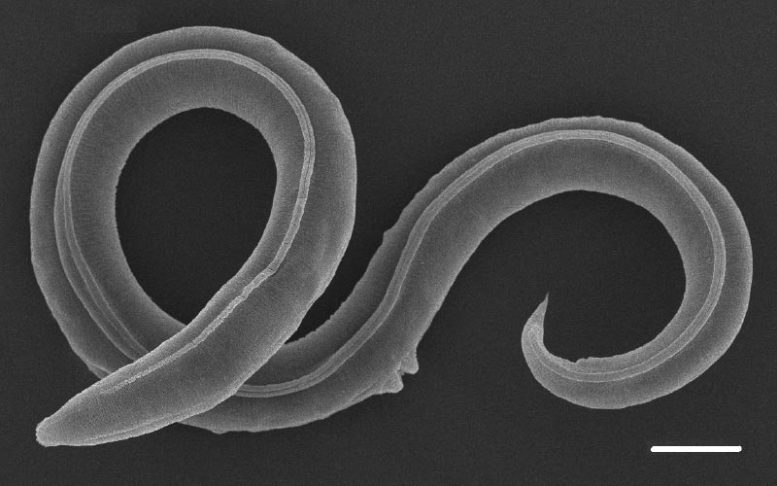
P. kolymaensis, female. Scanning electron picture. Credit: Alexei V. Tchesunov and Anastasia Shatilovich / Institute of Physicochemical and Biological Problems in Soil Science RAS
Revival and Initial Investigation of the Nematodes
When Anastasia Shatilovich at the Institute of Physicochemical and Biological Problems in Soil Science RAS in Russia revived two frozen individual nematodes from a fossilized burrow in silt deposits in the Siberian permafrost, she and her colleagues were beyond excited. After thawing the worms in the lab, a radiocarbon analysis of plant material from the burrow revealed that these frozen deposits, 40 meters below the surface, had not thawed since the late Pleistocene, between 45,839 and 47,769 years ago.
At the same time, the research group of Teymuras Kurzchalia at the MPI-CBG (Teymuras Kurzchalia is now retired) was already addressing the question of how larval stages of the nematode Caenorhabditis elegans survive extreme conditions. When the team heard about the permafrost nematodes, they immediately reached out for a collaboration with Anastasia Shatilovich.
Collaboration and Further Research
Vamshidhar Gade, a doctoral student at that time in the research group of Teymuras Kurzchalia, started to work with the permafrost nematodes. “What molecular and metabolic pathways these cryptobiotic organisms use and how long they would be able to suspend life are not fully understood,” he says. Vamshidhar is now working at the ETH in Zurich, Switzerland.
Genome Analysis and Species Identification
The researchers in Dresden conducted a high-quality genome assembly of one of the permafrost nematodes in collaboration with Eugene Myers, Director Emeritus and research group leader at the MPI-CBG, the DRESDEN-concept Genome Center, and the research group of Michael Hiller, research group leader at that time at the MPI-CBG and now Professor of Comparative Genomics at the LOEWE-TBG and the Senckenberg Society for Nature Research. Despite having DNA barcoding sequences and microscopic pictures, it was difficult to determine whether the permafrost worm was a new species or not.
Philipp Schiffer, research group leader at the Institute of Zoology, co-lead of the incipient Biodiversity Genomics Center Cologne (BioC2) at the University of Cologne, and expert in biodiversity genomics research, joined forces with the Dresden researchers to determine the species and analyze its genome with his team. Using phylogenomic analysis, he and his team were able to define the roundworm as a novel species, and the team decided to call it “Panagrolaimus kolymaensis.” In recognition of the Kolyma River region from which it originated, the nematode was given the Latin name Kolymaensis.
Survival Mechanism and Potential Implications
By comparing the genome of Panagrolaimus kolymaensis with that of the model nematode Caenorhabditis elegans, the researchers in Cologne identified genes that both species have in common and that are involved in cryptobiosis. To their surprise, most of the genes necessary for entering cryptobiosis in Caenorhabditis elegans so-called Dauer larvae were also present in Panagrolaimus kolymaensis.
Next, the research team evaluated Panagrolaimus kolymaensis’s ability to survive and discovered that mild dehydration exposure before freezing helped the worms prepare for cryptobiosis and increased survival at -80 degrees Celsius. At a biochemical level, both species produced a sugar called trehalose when mildly dehydrated in the lab, possibly enabling them to endure freezing and intense dehydration. Caenorhabditis elegans larvae also benefited from this treatment, surviving for 480 days at -80 degrees Celsius without suffering any declines in viability or reproduction following thawing.
Revelations
According to Vamshidhar Gade and Temo Kurzhchalia, “Our experimental findings also show that Caenorhabditis elegans can remain viable for longer periods in a suspended state than previously documented. Overall, our research demonstrates that nematodes have developed mechanisms that allow them to preserve life for geological time periods.”
“Our findings are essential for understanding evolutionary processes because generation times can range from days to millennia and because the long-term survival of a species’ individuals can result in the re-emergence of lineages that would otherwise have gone extinct,” concludes Philipp Schiffer, one of the authors who oversaw the study.
Eugene Myers adds: “P. kolymaensis‘s highly contiguous genome will make it possible to compare this feature to those of other Panagrolaimus species whose genomes are presently being sequenced by Schiffer’s team and colleagues.” Philipp Schiffer is convinced that “studying the adaptation of species to such extreme environments by analyzing their genomes will allow us to develop better conservation strategies in the face of global warming.”
Teymuras Kurzchalia says: “This study extends the longest reported cryptobiosis in nematodes by tens of thousands of years.”
Reference: “A novel nematode species from the Siberian permafrost shares adaptive mechanisms for cryptobiotic survival with C. elegans dauer larva” by Anastasia Shatilovich, Vamshidhar R. Gade, Martin Pippel, Tarja T. Hoffmeyer, Alexei V. Tchesunov, Lewis Stevens, Sylke Winkler, Graham M. Hughes, Sofia Traikov, Michael Hiller, Elizaveta Rivkina, Philipp H. Schiffer, Eugene W. Myers and Teymuras V. Kurzchalia, 27 July 2023, PLoS Genetics.
DOI: 10.1371/journal.pgen.1010798
This work was supported by the Russian Foundation fr Basic Research (19-29-05003-mk) to AS and ER. VRG and TVK acknowledge the financial support from the Volkswagen Foundation (Life research grant 92847). PHS and TTH are supported by a DFG ENP grant to PHS (DFG project 434028868). GMH is funded by a UCD Ad Astra Fellowship. The funders had no role in study design, data collection and analysis, decision to publish, or preparation of the manuscript.

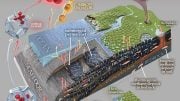
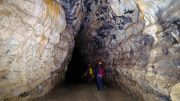
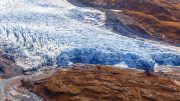
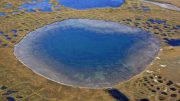

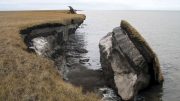

It may be a present time ring worm in Siberian frozen north.